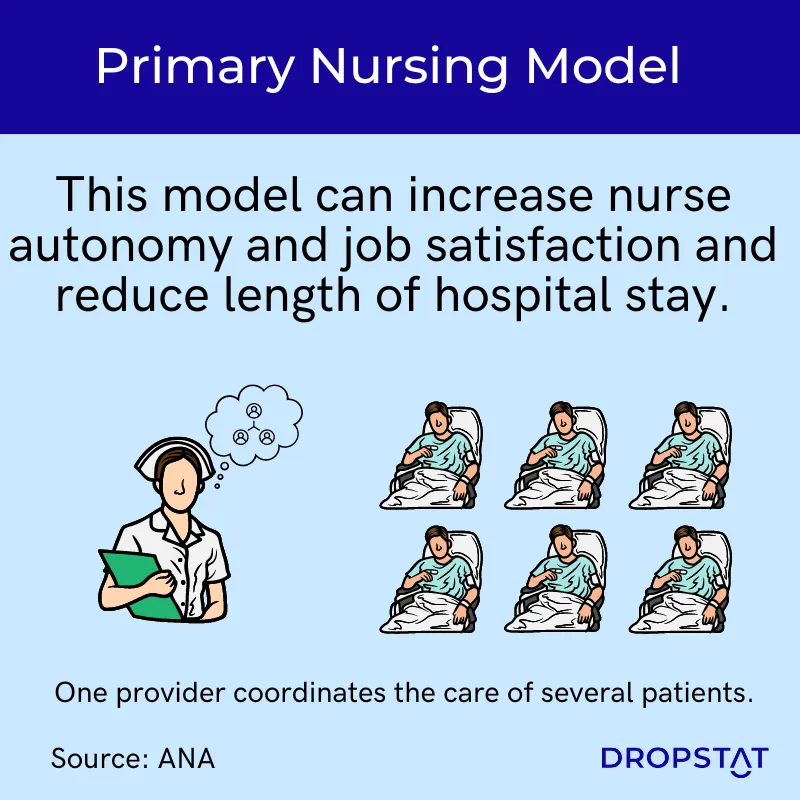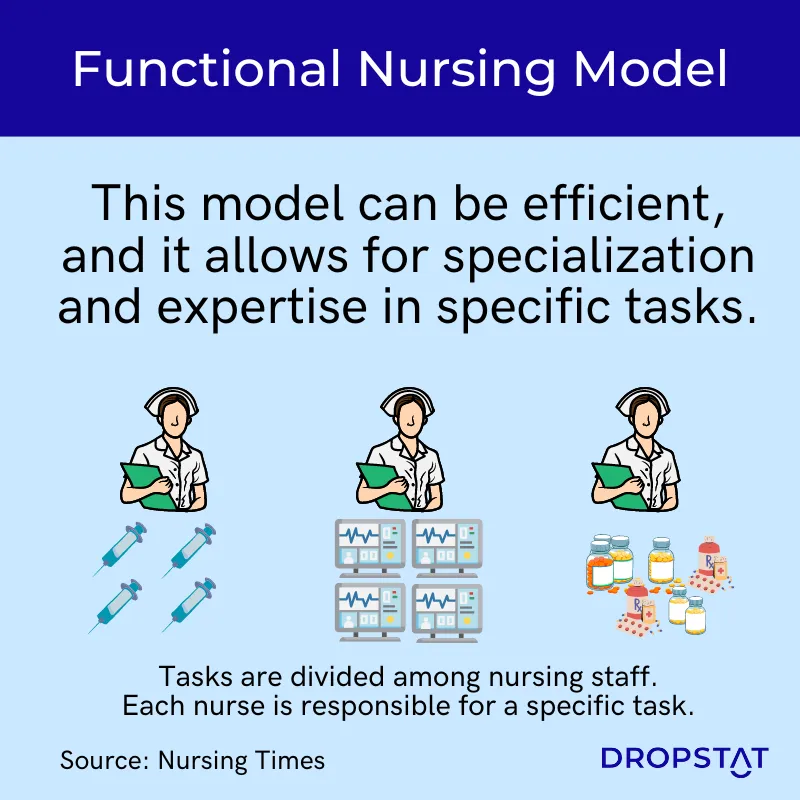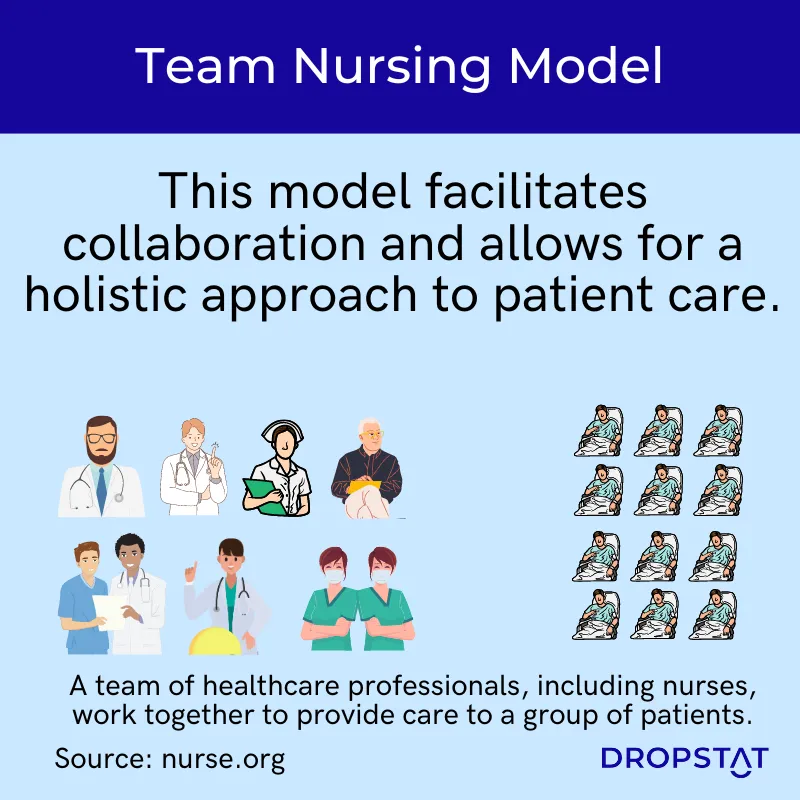What are nursing care models in healthcare delivery?
Nursing care delivery models are organizational frameworks that guide the way nurses provide care to patients. These models help to define the roles and responsibilities of nurses, as well as the scope of practice for each nurse. There are several nursing care delivery models, including
- primary nursing model
- functional nursing model
- team nursing model
- individual nursing model
Primary nursing model
The primary nursing model is a patient-centered approach in which care is delivered to patients by one nurse or primary care provider who manages the overall health and well-being of the patients.
The primary care provider is responsible for the coordination of care across a wide range of health needs, for the patient, from admission to discharge. This model allows the primary nurse or care provider to develop a relationship with the patients and their families, which can improve communication and trust.

Advantages of the primary nursing model
One of the main advantages of the primary nursing model is that it promotes continuity of care. The primary nurse is responsible for the care of several patients throughout their hospital stay. This enables the nurse to have a better understanding of each of the patient’s needs, and the nurse can provide personalized care. This can lead to better patient experience and satisfaction.
Another advantage of the primary nursing model is that it promotes accountability. The primary nurse is responsible for ensuring that patient care is coordinated and delivered effectively. This can lead to improved communication between nurses, physicians, and other healthcare providers.
Disadvantages of the primary nursing model
One of the main disadvantages of the primary nursing model is that it can be resource-intensive. Each patient requires a primary nurse, which can result in higher staffing levels and increased costs. This can be a challenge for healthcare facilities that are operating on tight budgets.
Another disadvantage of the primary nursing model is that it can be difficult to implement in facilities with high patient turnover rates. Assigning a primary nurse to each patient may not be feasible in facilities where patients are frequently admitted and discharged.
Functional nursing model
The functional nursing model is task-oriented and assigns specific tasks to each nurse based on their expertise. For example, one nurse may be responsible for administering medications, while another nurse may be responsible for performing assessments. This model allows nurses to focus on their areas of expertise, which can improve the quality of care.

Advantages of the functional nursing model
One of the main advantages of the functional nursing model is that it can be cost-effective. This model requires fewer nurses than the primary nursing model because each nurse is responsible for a specific task. This can be beneficial for healthcare facilities that are operating on tight budgets.
Another advantage of the functional nursing model is that it allows nurses to specialize in their areas of expertise. This can improve the quality of care because nurses are able to focus on the tasks that they are best equipped to handle.
Disadvantages of the functional nursing model
One of the main disadvantages of the functional nursing model is that it can result in fragmented care. Because each nurse is responsible for a specific task, there may be a lack of communication and coordination between nurses. This can lead to gaps in care and, potentially, negative patient outcomes.
Another disadvantage of the functional nursing model is the potential for losing accountability. Because each nurse is responsible for a specific task, there may be a lack of ownership for the overall care of the patient. A lack of coordination and communication between nurses could occur, which can result in suboptimal patient outcomes.
Team nursing model
The team nursing model is a collaborative approach to care delivery. In this model, a team of nurses works together to provide care to a group of patients. Each nurse is responsible for specific tasks, but they work together to coordinate care and communicate with each other.
Advantages of the team nursing model
One of the main advantages of the team nursing model is that it promotes collaboration and communication between nurses. Nurses work together to coordinate care and communicate with each other, which can be effective in improving patient outcomes and satisfaction.
Another advantage of the team nursing model is that it allows for flexibility. Nurses can work together to provide care to a group of patients, which means that they can adjust the workload among themselves based on the needs of the patients. This can be beneficial in facilities with high patient turnover rates.

Disadvantages of the team nursing model
One of the main disadvantages of the team nursing model is that it can be challenging to manage. Because nurses work in a team, there can be a lack of clarity regarding roles and responsibilities. This can lead to confusion and potentially negative patient outcomes.
Another disadvantage of the team nursing model is that it can be resource-intensive. The team nursing model requires more nurses than the functional nursing model, which can be a challenge for healthcare facilities that are operating on tight budgets.
Individual nursing care model
The individual nursing care model is an approach to nursing care that focuses on tailoring care to the unique needs and preferences of each individual patient. This model recognizes that every patient is unique and therefore requires individualized care that is tailored to their specific needs.
The individual nursing care model typically involves the following steps:
Assessment
The nurse assesses the patient’s physical, emotional, and psychosocial needs, as well as their preferences, values, and beliefs.
Planning
Based on the assessment, the nurse develops a care plan that is tailored to the individual patient’s needs and preferences. The care plan covers interventions, such as medication administration, wound care, and emotional support.
Implementation
The nurse implements the care plan, providing the necessary interventions and monitoring the patient’s response to treatment.
Evaluation
The nurse evaluates the effectiveness of the care plan and makes adjustments as needed.
Throughout the process, the nurse collaborates with the patient and their family to ensure that a patient’s care plan aligns with the patient’s goals and preferences. The individual nursing care model aims to provide holistic, patient-centered care that promotes the patient’s physical, emotional, and social well-being.

Advantages of the individual nursing care model
One advantage of the individual nursing care model is that it allows for highly customized care plans made especially for a patient’s unique needs, ensuring that care is delivered based on individual requirements.
Another advantage is that with one nurse assigned to each patient, a strong nurse-patient relationship can develop, fostering trust, rapport, and effective communication, leading to improved patient satisfaction and outcomes.
Disadvantages of the individual nursing care model
Assigning one nurse per patient can result in increased workload and staffing challenges, especially in busy healthcare settings, leading to potential nurse burnout and compromised care.
Providing individualized care can be resource-intensive, requiring higher staffing levels, increased time, and cost commitments. Financial constraints may limit the use of this care model.

Factors to consider when choosing nursing care delivery models
When choosing a nursing care model, healthcare facility CEOs should consider several practical factors, including
- Patient needs: The nursing care model can be adapted to the patient population. For example, the primary nursing model may be more appropriate for patients with complex medical needs, while the functional nursing model may be more appropriate for patients with less complex needs.
- Staffing levels: The nursing care model should be feasible given the staffing levels of the facility. The primary nursing model may be more challenging to implement in facilities with low staffing levels, while the functional nursing model may be more appropriate in these situations.
- Cost: The nursing care model should be cost-effective and sustainable for the facility. The team nursing model may be more expensive than the functional nursing model, but it may also lead to improved patient outcomes and satisfaction.
- Quality of care: The nursing care model should prioritize the quality of care for patients. The primary nursing model may lead to improved patient outcomes and satisfaction, but it may also be resource-intensive.

Aspects of nursing care delivery models that impact staff scheduling
Other factors that influence which care model is the best for a facility are examining how the nursing care model will impact staff well-being and staff scheduling. The best nursing care model for a facility is one that promotes safe and effective care delivery while supporting the well-being of nursing staff with an effective nurse shift schedule.
- Workload: The workload of nursing staff can significantly impact staff scheduling. Care models must match the workload, staffing levels, and skill mix of nursing staff to help ensure that they have adequate time and resources to provide safe and effective care. This can influence how schedules are organized.
- Staffing ratios: Staffing ratios can vary depending on the care model used. Different care models may have different staffing ratio requirements, and these ratios can impact how many nursing staff are needed and how schedules are structured.
- Skill mix: The skill mix of nursing staff can also impact staff scheduling. Care models that involve the use of different nursing roles, such as registered nurses (RNs), licensed practical nurses (LPNs), or nursing assistants, require accurately gauging the skill mix for each shift and how schedules are organized to ensure that the right staff with the appropriate skill set are available for each patient care situation.
- Shift length and rotation: The length and rotation of shifts, such as 8-hour, 10-hour, or 12-hour shifts, can also impact staff scheduling. Different care models may have different shift length requirements, and scheduling patterns may need to be adjusted accordingly to meet the needs of both nursing staff and patients.
- Staff preferences and availability: Care models that consider the preferences and availability of nursing staff can help promote job satisfaction and work-life balance and minimize scheduling conflicts.
- Staffing regulations and collective bargaining agreements: Staffing regulations and collective bargaining agreements may include requirements for minimum staffing levels, specific scheduling patterns, rest periods, and other scheduling-related considerations that need to be considered when choosing a nursing care model.
- Staff retention and recruitment: The ability to recruit and retain nursing staff can also be influenced by the care model used. Care models that are designed to optimize workload, job satisfaction, and work-life balance may help with staff retention and recruitment efforts and impact how schedules are structured to support a stable and satisfied nursing workforce.
How to choose the right nursing care models for your healthcare facility
Choosing the right nursing care models for each type of patient group means choosing the model that results in high-quality patient care and satisfaction, as well as high employee satisfaction.
It is important for healthcare facility CEOs to carefully evaluate their options and choose nursing care models that
- align with the needs of their patients,
- consider the well-being and mental health of their nurses and healthcare staff, and
- is possible with the resources available.
Dropstat is powerful in its flexibility, allowing every staff manager to have full control of staff scheduling from the palm of their hand.
Schedule a demo to see how Dropstat, a staff scheduling app built to accommodate every nursing care model, can improve your staff scheduling.







